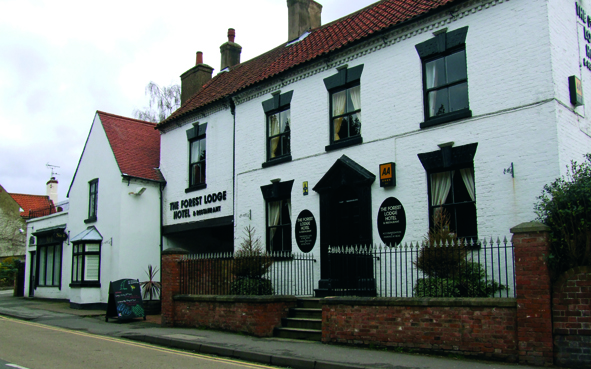Set on the edge of the area famed for being the home ground of Robin Hood, YHA Sherwood Forest…
Sherwood Forest's merrie tale

A walk among the age-old oaks of this legendary forest
5.5 miles (8.8kms)
About the walk
If Robin Hood or one of his merrie men were to return to Sherwood Forest today they would no doubt be surprised at how dramatically it has shrunk. The modern Sherwood Forest Country Park covers 450 acres (182ha), whereas the original area was more like 100,000 acres (40,500ha). But there again this vast ancient forest, which at the time of the Norman Conquest covered most of Nottinghamshire north of the River Trent, was not in fact a blanket forest but a mix of wood, heathland and scrub. It was the preserve of the nobility, where the King and his entourage hunted deer, and the commoners were subject to strict Forest Laws that could see a man's hand cut off for poaching.
Mighty oaks from little acorns grow
In England and Wales 'ancient woodland' generally refers to woods that have existed since 1600 (1750 in Scotland). Here at Sherwood the surviving woodland, though small, is a wonderful mix of native broadleaved varieties, dominated by oak and birch. Both varieties of native British oak can be found in the forest – common or English oak, and sessile or durmast oak – while newer conifer plantations extend the tree cover east and west.
The ancient woodland is full of light and atmosphere, and makes for magical walking. The highlight, however, is the gigantic old oak trees that pepper the forest. There are more than 900 trees above 600 years old (sometimes known as 'druids'), and while a few are simply gnarled and hollow old stumps, others still dominate the surroundings with their massive 'stag heads' of twisted limbs and spreading foliage.
The most famous of these is the Major Oak, visited on this walk, and one of the largest trees in England. Its exact age is somewhat uncertain, estimates having varied over the years from 500–1,500 years, but there's no doubting its sheer size. The hollow trunk is 33ft (10m) in circumference, and such is the spread of its colossal branches (92ft/28m) that they have to be propped up with artificial supports. But whether even the Major Oak's hollow trunk could have hidden Robin Hood and his entire band of merrie men, as legend has it, is rather more doubtful.
A changing landscape
Sherwood Forest has changed from a royal hunting ground to a source of valuable raw material. The use of English oak by everyone from shipbuilders and furniture-makers to miners and charcoal burners mean that between 1609 and 1790 their number plummeted by 80 per cent.
In 2005, Sherwood Forest was declared a National Nature Reserve, and there are plans to move the Visitor Centre to a new location outside the boundary of the reserve. Although much delayed, the new centre is due to open in 2015 at a location near Edwinstowe.
Walk directions
Facing the main entrance to Sherwood Forest Visitor Centre from the car park, turn left and follow the well-signposted route to the Major Oak.
Go along the curving path as it completes a semi-circle around the impressive old tree and continue as far as the junction with a public bridleway (signposted). Turn left here, then walk this straight and uncomplicated route for 0.25 miles (400m), ignoring all paths off.
Where the main path bears left go straight on, following the public bridleway sign past a metal bar gate. The path continues over a crossroads to become a wide, fenced track through pleasant open country of heather and bracken known as Budby South Forest.
At the very far side go through a gate and turn left on to an unmade lane, and walk this undulating route for 0.75 miles (1.2km).
At the major junction just before the plantation begins, turn left, indicated 'Centre Tree'. With the rows of conifers on your right, and good views across Budby South Forest on your left, keep to this straight and obvious track. Where the track divides into two parallel trails, the gravelly track on the right is technically the cycle route, while the more leafy and grassy ride to the left is the bridleway, but either can be used.
When you reach the Centre Tree – a huge spreading oak – the two routes converge to continue past a bench down a wide avenue among the trees. Don't go down this, but instead turn left and, ignoring paths off right and left, carry straight on along the main track back into the heart of the forest.
After almost 0.75 miles (1.2km) you pass a metal bar gate on the right and then meet a bridleway coming in from the left. Ignoring the inviting path straight ahead (which returns to the Major Oak) bear right on the wide track, past some bare holes and dips. At a large junction of criss-crossing routes go straight on (signposted 'Fairground') so that an open field and distant housing becomes visible to your right. This wide sandy track descends to a field by Edwinstowe cricket ground. The Art and Craft Centre and Sherwood Youth Hostel are on the far side, and the village centre beyond.
To return to the visitor centre and car park, follow the well walked, signposted track back up past the cricket ground.
Additional information
Easy woodland tracks and wide forest rides
Beautiful mixed woodland, more open to north
On lead around Visitor Centre, otherwise excellent
OS Explorer 270 Sherwood Forest
Sherwood Forest Visitor Centre (pay-and-display)
Sherwood Forest Visitor Centre
WALKING IN SAFETY
Read our tips to look after yourself and the environment when following this walk.
Find out more
Also in the area
About the area
Discover Nottinghamshire
Most people associate Nottinghamshire in the East Midlands with the legend of Robin Hood, though the former royal hunting ground of Sherwood Forest has been somewhat tamed since Robin’s outlaw days. Traditionally, the county’s primary industry, alongside agriculture, was coal mining but it is also an oil producing area, and during World War II produced the only oil out of reach of the German U-Boats.
The county is divided between the old coalfields north of the city of Nottingham, the commuter belt of the Wolds to the south, Sherwood Forest and the great country estates known as the ‘Dukeries’. Towns of note are the river port and market town of Newark, which hosts major antiques fairs six times a year, and Southwell, known for the medieval minster with exquisite carvings of Sherwood Forest.
D H Lawrence was a Nottinghamshire man, born in Eastwood, the son of a miner and former schoolteacher. He grew up in poverty, and his book Sons and Lovers reflects the experiences of his early years. Other Nottinghamshire notables include Thomas Cranmer, the first Protestant Archbishop; Jesse Boot, founder of the Boots pharmaceutical company; Henry Ireton, the man who singed Charles I’s death warrant; and Olympic skaters Torvill and Dean.
Nearby stays
Restaurants and Pubs
Nearby experiences
Recommended things to do
Why choose Rated Trips?
Your trusted guide to rated places across the UK
The best coverage
Discover more than 15,000 professionally rated places to stay, eat and visit from across the UK and Ireland.
Quality assured
Choose a place to stay safe in the knowledge that it has been expertly assessed by trained assessors.
Plan your next trip
Search by location or the type of place you're visiting to find your next ideal holiday experience.
Travel inspiration
Read our articles, city guides and recommended things to do for inspiration. We're here to help you explore the UK.
















